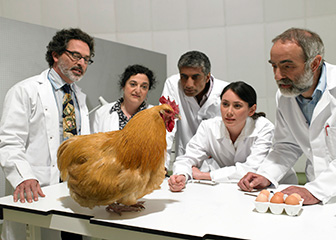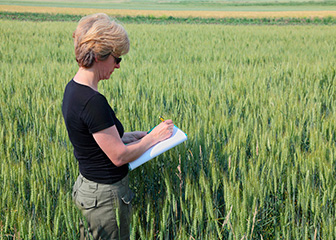How to Become an Agricultural or Food Scientist About this section

Most animal scientists earn a Ph.D., whereas food scientists and technologists, as well as soil and plant scientists, typically earn a bachelor’s degree.
Agricultural and food scientists need at least a bachelor’s degree from an accredited postsecondary institution, although many obtain a doctoral degree. Food scientists and technologists and soil and plant scientists typically earn bachelor’s degrees. Some scientists earn a Doctorate of Veterinary Medicine (DVM). Most animal scientists earn a Ph.D.
Education
Every state has a land-grant college that offers agricultural science degrees. Many other colleges and universities also offer agricultural science degrees or agricultural science courses. Degrees in related sciences, such as biology, chemistry, or physics, or in a related engineering specialty also may qualify people for many agricultural science jobs.
Undergraduate coursework for food scientists and technologists and for soil and plant scientists typically includes biology, chemistry, botany, and plant conservation. Students preparing to be food scientists take courses such as food chemistry, food analysis, food microbiology, food engineering, and food processing operations. Students preparing to be soil and plant scientists take courses in plant pathology, soil chemistry, entomology (the study of insects), plant physiology, and biochemistry.
Students typically gain a strong foundation in their field, with an emphasis on teamwork, internships, and research opportunities. In addition to science coursework, undergraduates sometimes take humanities courses, which help them develop good communication skills.
Many people with bachelor's degrees in agricultural sciences find work in related jobs rather than becoming an agricultural or food scientist. For example, a bachelor's degree in agricultural science is useful for managerial jobs in farm-related or ranch-related businesses, such as farming, ranching, agricultural inspection, farm credit institutions, or companies that make or sell feed, fertilizer, seed, and farm equipment.
Graduate study further develops an animal scientist’s knowledge, and it typically takes students 6 years to complete their Ph.D. During graduate school, there is additional emphasis on lab work and original research, where prospective animal scientists have the opportunity to do experiments and sometimes supervise undergraduates.
Advanced research topics include genetics, animal reproduction, and biotechnology, among others. Advanced coursework also emphasizes statistical analysis and experiment design, which are important as Ph.D. candidates begin their research.
Some agricultural and food scientists receive a Doctor of Veterinary Medicine before they begin their animal science training. Like candidates for a Ph.D. in animal science, a prospective veterinarian must first have a bachelor’s degree before getting into veterinary school. For more information, see the profile on veterinarians.
Important Qualities
Communication skills. Communication skills are critical for agricultural and food scientists. They must be able to explain their studies: what they were trying to learn, the methods they used, what they found, and what they think the implications are of their findings. They must also be able to communicate well when working with others, including technicians and student assistants.
Critical-thinking skills. Agricultural and food scientists must use their expertise to determine the best way to answer a specific research question.
Data-analysis skills. Agricultural and food scientists, like other researchers, collect data using a variety of methods, including quantitative surveys. They must then apply standard data analysis techniques to understand the data and get the answers to the questions they are studying.
Decision-making skills. Agricultural and food scientists must use their expertise and experience to determine whether their findings will have an impact on the food supply, farms, and other agricultural products.
Observation skills. Agricultural and food scientists conduct experiments that require precise observation of samples and other data. Any mistake could lead to inconclusive or inaccurate results.
Certification
Agricultural and food scientists can get certifications from organizations like the American Registry of Professional Animal Scientists (ARPAS), or the Soil Science Society of America (SSSA). These certifications recognize expertise in agricultural and food science and enhance the status of those who are certified.
According to the organizations, certification of professional expertise is broadly based on education, a comprehensive exam, and previous professional experience. Scientists must take continuing education courses every year to keep their certification, and they must follow the organization's code of ethics. Certification is not required, but the agricultural and food science community recognizes its importance. Some states require soil scientists to be licensed to practice. Licensing requirements vary by state, but generally include holding a bachelor’s degree with a certain number of credit hours in soil science, a certain number of years working under a licensed scientist, and passage of an examination.














